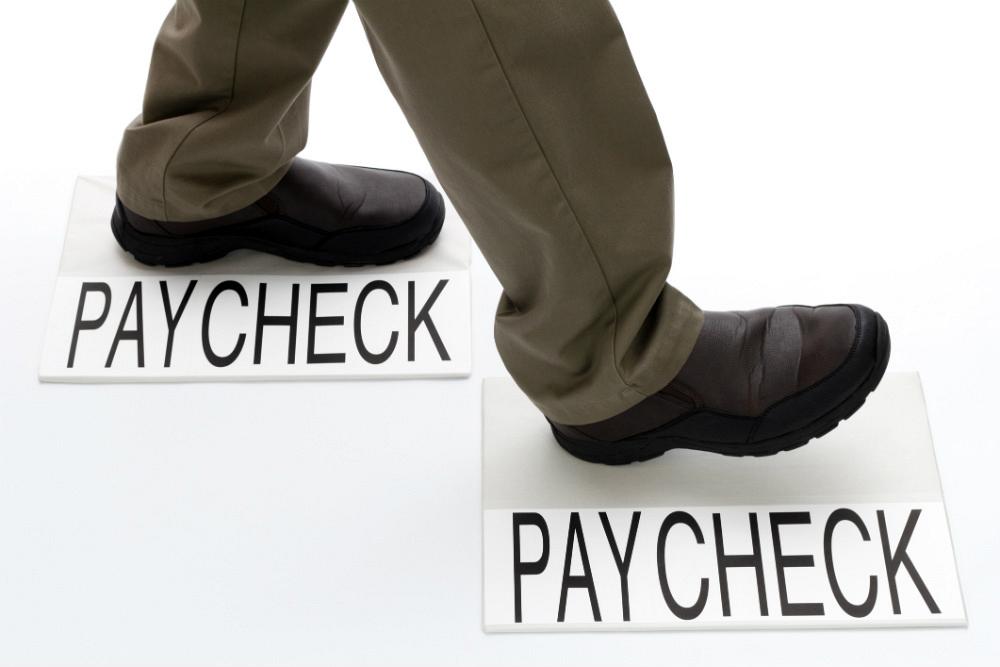- FMA
- The Fabricator
- FABTECH
- Canadian Metalworking
Categories
- Additive Manufacturing
- Aluminum Welding
- Arc Welding
- Assembly and Joining
- Automation and Robotics
- Bending and Forming
- Consumables
- Cutting and Weld Prep
- Electric Vehicles
- En Español
- Finishing
- Hydroforming
- Laser Cutting
- Laser Welding
- Machining
- Manufacturing Software
- Materials Handling
- Metals/Materials
- Oxyfuel Cutting
- Plasma Cutting
- Power Tools
- Punching and Other Holemaking
- Roll Forming
- Safety
- Sawing
- Shearing
- Shop Management
- Testing and Measuring
- Tube and Pipe Fabrication
- Tube and Pipe Production
- Waterjet Cutting
Industry Directory
Webcasts
Podcasts
FAB 40
Advertise
Subscribe
Account Login
Search
Livin’ la vida paycheck-to-paycheck
- By Vicki Bell
- August 29, 2017
Amid the recent news of the catastrophic flooding in Texas, North Korea firing a missile over Japan, and political protests, some news about the U.S. job picture may have gone unnoticed.
As CNN Money reported, on the positive side, the unemployment rate fell to 4.3 percent in July, down from 4.8 percent when Trump took office.
“The most recent Labor Department data shows there were 5.7 million unfilled job openings -- close to the record number since it started keeping track in 2000.
“The odds have become much better for people looking for work. Nearly twice as many people are quitting jobs as are being laid off or fired -- a sign of a strong labor market.
“Trump's record of 1.1 million jobs in six months is less than the 1.2 million added during the same period a year ago under Obama. It essentially matches the first six months of Obama's second term, when 1.1 million jobs were added.”
Good news, right? Low unemployment rate, many job openings, workers feeling confident that they can quit their jobs and find another. What more could we ask for?
How about that ever-elusive livable wage?
Last week, CareerBuilder released the results of a nationwide survey conducted online by Harris Poll from May 24 to June 16, 2017. More than 3,462 full-time U.S. workers and more than 2,369 full-time hiring and human resource managers in the private sector participated. The findings?
“More than three-quarters of Americans (78 percent) are living paycheck-to-paycheck to make ends meet—up from 75 percent last year and a trait more common in women than men—81 versus 75 percent. Thirty-eight percent of employees said they sometimes live paycheck-to-paycheck, 17 percent said they usually do, and 23 percent said they always do.”
And, as Gomer Pyle might say, surprise, surprise, surprise—having a higher salary doesn't necessarily mean money woes are behind you, with nearly one in 10 workers making $100,000 or more (9 percent) saying they usually or always live paycheck-to-paycheck and 59 percent in that income bracket are in debt. Twenty-eight percent of workers making $50,000-$99,999 usually or always live paycheck to paycheck and 70 percent are in debt; 51 percent of those making less than $50,000 usually or always live paycheck-to-paycheck to make ends meet and 73 percent are in debt.“‘As an employer, your employees' financial problems become your financial problems,’ said Rosemary Haefner, chief human resources officer for CareerBuilder. ‘If workers are constantly thinking about their financial struggles, their quality of work can decrease, and it can take a hit on their morale and productivity. If you do what you can to help people keep their finances under control — by doing things such as matching 401(k) contributions or hosting financial planning seminars — you'll ease some of their financial worries and it will be less likely to have a negative impact on your business.’”
The majority of workers (81 percent) have worked a minimum-wage job, and 71 percent of them were not able to make ends meet financially during that time. More than half (54 percent) had to work more than one job.
Not exactly a rosy picture, is it? However, one statistic in the report looks promising, provided the number continues to grow. “To alleviate some financial burden, 83 percent of employers that are hiring minimum-wage workers this year (45 percent) will be raising the minimum wage at their organization.”
Of course, depending on the employer’s current minimum, that raise still might (likely will) fall far short of providing a livable wage.
If you’re among the 78 percent, CareerBuilder suggests “Five Ways to Stop Living Paycheck to Paycheck.” No. 5? Get a side hustle—not to be confused with a second job.
subscribe now

The Fabricator is North America's leading magazine for the metal forming and fabricating industry. The magazine delivers the news, technical articles, and case histories that enable fabricators to do their jobs more efficiently. The Fabricator has served the industry since 1970.
start your free subscriptionAbout the Author

Vicki Bell
2135 Point Blvd
Elgin, IL 60123
815-227-8209
- Stay connected from anywhere

Easily access valuable industry resources now with full access to the digital edition of The Fabricator.

Easily access valuable industry resources now with full access to the digital edition of The Welder.

Easily access valuable industry resources now with full access to the digital edition of The Tube and Pipe Journal.
- Podcasting
- Podcast:
- The Fabricator Podcast
- Published:
- 04/16/2024
- Running Time:
- 63:29
In this episode of The Fabricator Podcast, Caleb Chamberlain, co-founder and CEO of OSH Cut, discusses his company’s...
- Trending Articles
Tips for creating sheet metal tubes with perforations

Supporting the metal fabricating industry through FMA

JM Steel triples capacity for solar energy projects at Pennsylvania facility

Are two heads better than one in fiber laser cutting?

Fabricating favorite childhood memories

- Industry Events
16th Annual Safety Conference
- April 30 - May 1, 2024
- Elgin,
Pipe and Tube Conference
- May 21 - 22, 2024
- Omaha, NE
World-Class Roll Forming Workshop
- June 5 - 6, 2024
- Louisville, KY
Advanced Laser Application Workshop
- June 25 - 27, 2024
- Novi, MI



























